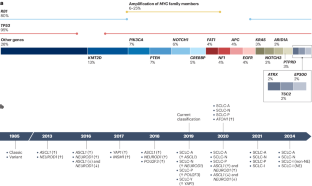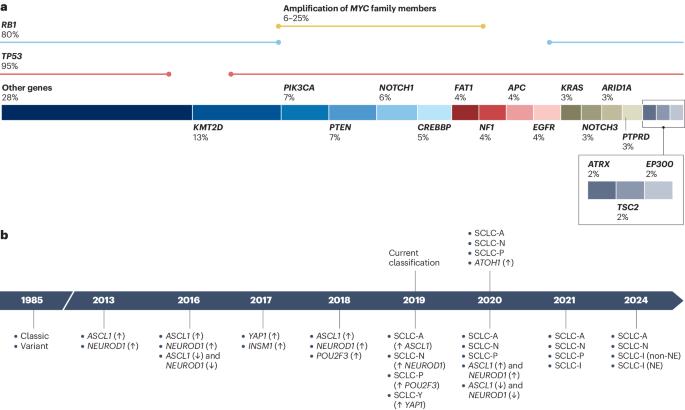在确定小细胞肺癌的分子和治疗前景方面取得的新进展。
IF 82.2
1区 医学
Q1 ONCOLOGY
引用次数: 0
摘要
小细胞肺癌(SCLC)历来被认为是一种顽固性癌症,预后不佳,在过去几十年中,治疗策略只取得了微不足道的进展。对小细胞肺癌进行的全面基因组评估显示,这些肿瘤大多存在肿瘤抑制基因TP53和RB1的缺失,但与非小细胞肺癌相比,却未能发现可靶向的改变。在SCLC发病机制中起关键作用的四种转录因子的表达状态界定了该疾病的不同分子亚型,从而有可能确定特定的治疗方法。MYC 对映体的过表达和扩增也会影响 SCLC 的生物学特性和治疗弱点。过去几年还出现了其他一些有吸引力的靶点,包括DNA损伤反应途径抑制剂、表观遗传修饰剂、抗体药物共轭物和嵌合抗原受体T细胞。然而,治疗耐药性的快速发展以及缺乏有效筛选SCLC患者的生物标志物是目前面临的挑战。新出现的单细胞RNA测序数据让人们对SCLC的可塑性、瘤内和瘤间异质性有了更深入的了解,而这可能与治疗耐药性有关。在这篇综述中,我们将全面概述 SCLC 基因组和转录组特征描述的最新进展,尤其关注将其转化为新的治疗方法以改善患者预后的机会。本文章由计算机程序翻译,如有差异,请以英文原文为准。


Emerging advances in defining the molecular and therapeutic landscape of small-cell lung cancer
Small-cell lung cancer (SCLC) has traditionally been considered a recalcitrant cancer with a dismal prognosis, with only modest advances in therapeutic strategies over the past several decades. Comprehensive genomic assessments of SCLC have revealed that most of these tumours harbour deletions of the tumour-suppressor genes TP53 and RB1 but, in contrast to non-small-cell lung cancer, have failed to identify targetable alterations. The expression status of four transcription factors with key roles in SCLC pathogenesis defines distinct molecular subtypes of the disease, potentially enabling specific therapeutic approaches. Overexpression and amplification of MYC paralogues also affect the biology and therapeutic vulnerabilities of SCLC. Several other attractive targets have emerged in the past few years, including inhibitors of DNA-damage-response pathways, epigenetic modifiers, antibody–drug conjugates and chimeric antigen receptor T cells. However, the rapid development of therapeutic resistance and lack of biomarkers for effective selection of patients with SCLC are ongoing challenges. Emerging single-cell RNA sequencing data are providing insights into the plasticity and intratumoural and intertumoural heterogeneity of SCLC that might be associated with therapeutic resistance. In this Review, we provide a comprehensive overview of the latest advances in genomic and transcriptomic characterization of SCLC with a particular focus on opportunities for translation into new therapeutic approaches to improve patient outcomes. Traditionally, patients with small-cell lung cancer (SCLC), a malignancy with a dismal prognosis, have had limited treatment options. Over the past few years, advances in the molecular characterization of SCLC have revealed novel therapeutic targets. The authors of this Review summarize these findings and discuss emerging opportunities and challenges for their translation into new treatment approaches.
求助全文
通过发布文献求助,成功后即可免费获取论文全文。
去求助
来源期刊
CiteScore
99.40
自引率
0.40%
发文量
114
审稿时长
6-12 weeks
期刊介绍:
Nature Reviews publishes clinical content authored by internationally renowned clinical academics and researchers, catering to readers in the medical sciences at postgraduate levels and beyond. Although targeted at practicing doctors, researchers, and academics within specific specialties, the aim is to ensure accessibility for readers across various medical disciplines. The journal features in-depth Reviews offering authoritative and current information, contextualizing topics within the history and development of a field. Perspectives, News & Views articles, and the Research Highlights section provide topical discussions, opinions, and filtered primary research from diverse medical journals.

 求助内容:
求助内容: 应助结果提醒方式:
应助结果提醒方式:


